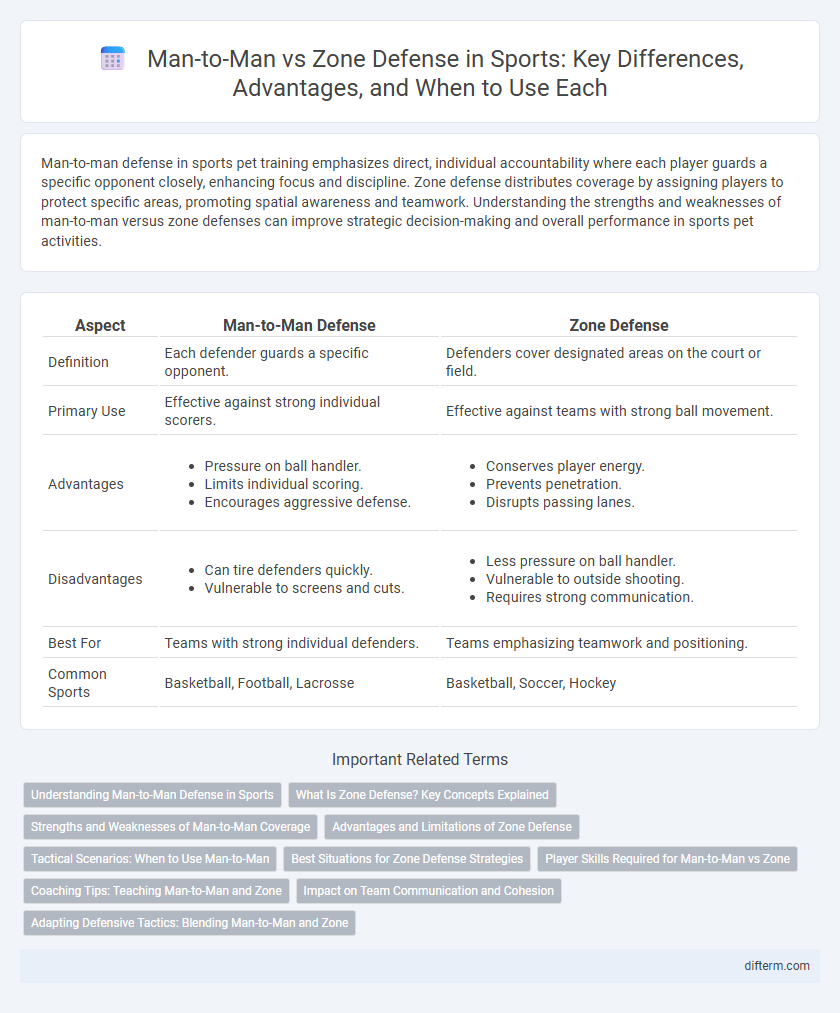Man-to-man defense in sports pet training emphasizes direct, individual accountability where each player guards a specific opponent closely, enhancing focus and discipline. Zone defense distributes coverage by assigning players to protect specific areas, promoting spatial awareness and teamwork. Understanding the strengths and weaknesses of man-to-man versus zone defenses can improve strategic decision-making and overall performance in sports pet activities.
Table of Comparison
| Aspect | Man-to-Man Defense | Zone Defense |
|---|---|---|
| Definition | Each defender guards a specific opponent. | Defenders cover designated areas on the court or field. |
| Primary Use | Effective against strong individual scorers. | Effective against teams with strong ball movement. |
| Advantages |
|
|
| Disadvantages |
|
|
| Best For | Teams with strong individual defenders. | Teams emphasizing teamwork and positioning. |
| Common Sports | Basketball, Football, Lacrosse | Basketball, Soccer, Hockey |
Understanding Man-to-Man Defense in Sports
Man-to-man defense assigns each player the responsibility to guard a specific opponent, enhancing accountability and pressure on the ball handler. This strategy improves defensive communication and helps in identifying mismatches, enabling teams to disrupt offensive plays effectively. Mastery of man-to-man principles is crucial for sports like basketball and football, where constant adaptation to opponent movements determines defensive success.
What Is Zone Defense? Key Concepts Explained
Zone defense is a basketball strategy where each player is responsible for guarding an assigned area of the court instead of a specific opponent. This approach emphasizes spatial awareness, team coordination, and quick help defense to protect key zones like the paint and perimeter. Zone defenses disrupt offensive flow by limiting passing lanes and forcing contested perimeter shots.
Strengths and Weaknesses of Man-to-Man Coverage
Man-to-man coverage excels in applying intense pressure on individual offensive players, enabling defenders to disrupt passes and force turnovers through tight marking and physicality. However, it often demands high stamina and communication, as defenders must constantly track their assigned opponent, increasing the risk of mismatches or blown assignments. This defense can be vulnerable to quick ball movement and screens that create open spaces, requiring excellent anticipation and agility from defenders to adjust effectively.
Advantages and Limitations of Zone Defense
Zone defense in sports offers the advantage of protecting key areas on the court or field, allowing players to cover multiple offensive threats simultaneously. This strategy reduces the likelihood of penetration by forcing opponents to take difficult outside shots, enhancing team cohesion and energy conservation. However, zone defense can be vulnerable to precise perimeter shooting and quick ball movement, potentially creating open lanes and mismatches for well-coordinated offenses.
Tactical Scenarios: When to Use Man-to-Man
Man-to-man defense excels in scenarios requiring tight, personalized coverage against skilled individual offensive players, such as guarding prolific shooters or primary ball handlers. It is especially effective during late-game situations where controlling matchups can prevent key players from scoring critical points. This tactic also allows for aggressive pressure and quick passes interceptions, making it ideal when a team aims to disrupt an opponent's offensive rhythm.
Best Situations for Zone Defense Strategies
Zone defense strategies excel in protecting the paint and limiting high-percentage inside shots, making them ideal against teams with strong post players but less effective outside shooting. They are best deployed when facing offenses that rely heavily on perimeter shooters, as the zone forces contested long-range shots and disrupts passing lanes. In situations where team communication and rotational speed are high, zone defenses can effectively neutralize motion offenses by clogging driving lanes and forcing poor shot selection.
Player Skills Required for Man-to-Man vs Zone
Man-to-man defense demands superior individual athleticism, agility, and quick decision-making as players must closely guard their opponents and react instantly to their moves. In contrast, zone defense emphasizes spatial awareness, communication, and teamwork to effectively cover assigned areas and anticipate offensive plays. Mastery of footwork and anticipation is crucial in both strategies but manifests differently in the context of personal matchup versus area coverage.
Coaching Tips: Teaching Man-to-Man and Zone
Effective coaching tips for teaching man-to-man defense emphasize communication, positioning, and anticipation to enhance individual accountability and team cohesion. For zone defense, coaches should focus on spatial awareness, quick rotations, and understanding opponent tendencies to maintain coverage integrity and limit scoring opportunities. Incorporating drills that simulate game scenarios helps players adapt to both defensive strategies, improving overall responsiveness and execution.
Impact on Team Communication and Cohesion
Man-to-man defense demands constant individual communication as players must call out screens and switches, fostering heightened team awareness and accountability. Zone defense relies on cohesive spatial coverage, requiring players to communicate effectively about ball movement and positioning to prevent gaps. Effective communication in both systems enhances defensive synchronization, with man-to-man emphasizing personal accountability and zone promoting collective responsibility.
Adapting Defensive Tactics: Blending Man-to-Man and Zone
Blending man-to-man and zone defenses enhances team adaptability by exploiting each strategy's strengths, such as the personalized pressure of man-to-man and the spatial coverage of zone. Effective defensive schemes often integrate switching between these tactics mid-game to disrupt opponents' offensive rhythm and force turnovers. Coaches leverage hybrid defenses to confuse shooters, protect the paint, and cover passing lanes, maximizing defensive efficiency in competitive sports.
man-to-man vs zone Infographic

 difterm.com
difterm.com